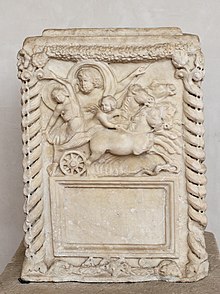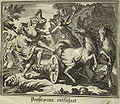Rape of Persephone
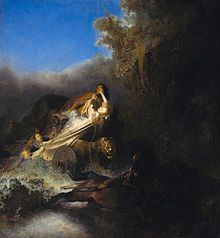
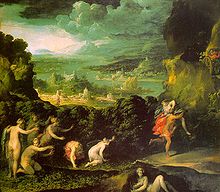

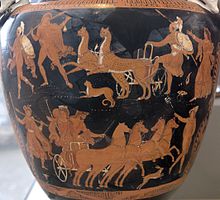
The robbery of Persephone in Greek mythology or the robbery of Proserpine in Roman mythology is the story of the kidnapping of Kore, Demeter's daughter (Latin: Ceres ), by Hades (Latin: Pluto ), the ruler of the underworld the desperate search of the mother and the found solution, for which Kore as Persephone , queen of the dead, only spends part of the year in the underworld. This myth acts as an aition that nature only bears fruit for part of the year.
myth
The myth of the robbery of Persephone exists in several versions in different sources. It is already mentioned briefly in the Theogony (verse 914), which Hesiod wrote around 700 BC. Chr. Composed. One of the earliest textual testimonies , a choir song in Helena des Euripides (412 BC), names the mountain mother from the Ida Mountains in Asia Minor as the mother of the stolen girl. In the fourth century AD, Claudius Claudianus wrote De raptu Proserpinae , an epic in three books.
First the probably oldest, almost complete story, namely the Homeric hymn 2 To Demeter , is to be reproduced and then the most important version for the aftermath and the art history of the modern age, namely that of the Roman poet Ovid .
Homeric hymn
prehistory
Hades, god of the underworld and brother of Zeus, falls in love with Kore. He therefore asks Zeus for Kore as a woman. Knowing that Kore would not willingly go to the sunless underworld, Zeus neither agrees nor disagrees. Hades interprets this as consent.
robbery
At this point the Homeric hymn begins. He draws an idyll that is suddenly interrupted:
- Far from Demeter, the mistress of the harvest, which cuts with a golden sickle, she played and picked flowers with the daughters of Oceanus , roses, crocuses and beautiful violets, irises, hyacinths and daffodils. The earth produced the daffodil as a wonderful trap for the beautiful girl according to Zeus' plan to please Hades, who receives all. It was a wonderful sight for everyone, immortal gods and mortal people, from its roots grew a hundred little heads, which gave off such a sweet scent that the whole wide sky above and the whole earth laughed and the salty flood of the sea. The girl was charmed and stretched out both hands to grab the splendor. But when she did, the earth opened and the ruler Hades, whom we will all meet, broke forth with his immortal horses on the plain of Nysa . The Lord Hades, son of Cronus, who is called by many names. Pleading for mercy, she was dragged into the golden car.
Demeter's search
Nobody heard Kore's screams, except Helios , the sun god, who never lets go of things on earth, and Hecate in her cave. Finally, however, Kore's distress reached the ear of the mother, who immediately set out to look for the daughter, but could not find her. For nine days she wandered the earth, consuming neither ragweed nor nectar ; for nine nights, a torch in hand , she searched for a trace of her daughter. Finally, on the tenth day, she met Hecate, who also carried a torch and told her about the kidnapping, but could not name the kidnapper.
Demeter and Hecate then climbed, both flaming torches in their hands, to the palace of Helios, who, in response to her insistent plea, opened up to Demeter that Hades had stolen her daughter. But she shouldn't worry too much about it, he was a god, besides, her brother and ruler over a third of the world.
Demeter in Eleusis
Demeter, however, was appalled by the robbery and far from calming down. She wanted nothing more to do with the gods and left Olympus , transformed her form into that of an old woman and thus wandered among the people she did not recognize. So she came to Eleusis to the Fountain of Virgins , where she settled under an olive tree. The daughters of King Keleos of Eleusis came to this fountain : Kallidike , Kleisidike , Demo and Kallithoe . They ask the supposed old woman where she comes from and why she is so far from home. Demeter replied that her name was Doso, that she came from Crete and had been robbed by pirates, but eventually escaped.
Thereupon the daughters of Keleos invited Demeter to the house of their father, where they were kindly received by his wife Metaneira . But the goddess was silent and full of sadness, didn't want to eat or drink anything until the servant Iambe made her smile with loose jokes. She refused the offered wine, but instead asked for Kykeon as a drink. The goddess then took care of Demophoon, the late-born son of Keleos and Metaneira. She anointed the boy with ambrosia, which made him thrive and looked more like a god than a man, but when she held him in the fire one night to make him so immortal, she was surprised by Metaneira, who uttered a great shout, because she said a crazy old nurse was going to burn her son.
As a result, the goddess was very angry and tore the boy out of the fire, causing him to die. Then she showed herself in her true form and demanded that a temple be built for her in Eleusis, which was done. When Demeter finally founded the Mysteries of Eleusis , Keleos became the first of the high priests.
Kore's return
Before that, however, she let her anger and despair run free: She ordered the plants not to sprout anymore, and soon all the land was deserted, so that there was a danger that all people would die of hunger and the gods would remain alone in Olympus without the sacrificial smoke clouds so pleasant to them so far. Zeus therefore sent Hermes to Hades to release Kore for the general good of the gods.
Hades seemed reluctant to bow to Zeus 'will, but forced Persephone to eat a few pomegranate seeds before she got into Hermes' carriage . When Kore had now returned to Demeter, the mother asked her whether she had not eaten anything in the underworld, whereupon Kore confessed that Hades had forced her to eat a few pomegranate seeds. Since that happened and no one who has tasted the food of the dead can stay in the upper world permanently, Persephone had to live four months in the underworld with Hades, the remaining eight months she was allowed to spend on earth with her mother. Demeter finally resigned himself to this regulation and agreed to restore the fertility of the earth. She descended to earth, where she made the first grain sprout on the field of Rharos near Eleusis and founded the Eleusinian Mysteries. The four months in the underworld represent the sterile time on earth, Demeter is sad, and therefore no plant blooms, but when her daughter is with her everything blooms and flourishes.
Metamorphoses of Ovid
The subject of the robbery of Proserpine was dealt with twice by Ovid, namely in his most famous work, the Metamorphoses , and in the Fasti .
robbery
The metamorphoses begin with a slightly different description: In the Gigantomachy , the giant Typhon was buried under Sicily , where he still fought restlessly against his gang and shook the earth. Pluto in the underworld fears for himself and his kingdom and above all that the earth might burst and the sun shine into his shadowy kingdom. The timid Hades has tradition. The theogony of Hesiod says that Hades remained trembling in the underworld while his brother Zeus valiantly fought a battle with Typhon and eventually defeated him. To calm himself down, Pluto climbs into his cart, drawn by four black horses, to inspect the foundations of Sicily.

On this trip Venus notices him , who is enthroned high on the mountains in the company of Cupid . She thinks that after no part of the world should be spared from Cupid's arrows, the underworld should now also feel its part in the power of love. And besides, the still virgin Proserpine is already a thorn in her side. Minerva and Diana had already pledged themselves to virginity and withdrew their power, they could not take it any longer if it spread. Amor should immediately hit Pluto, who was frowning at the foundations of the island, with his arrow.
The kidnapping takes place at Ovid on Lake Pergusa near Enna in Sicily:
With a deep tide, near the walls of Henna,
called Pergus, lies a lake. More songs from swans than this one
does not even hear in the current of floating Caystro waves .
All around the bank, forest wreaths the waters and fends off
Phöbus' glowing stab with the leaves, as if with a protective curtain.
The branches are cooled and the Au nourishes Tyrian flowers.
Constant spring prevails. ...
Pluto, hit by Cupid's arrow, sees Proserpina playing with her companions and picking flowers, burns in love, grabs her and races away - “that's the rush of sudden love” - over stick, stone and the sulphurous Palicorum Lacus .
The nymph Cyane had the courage to stand in the way of Hades, but Hades let the earth open and drove with the carriage and the reluctant bride down into the underworld. Cyane was so heartbroken over her failure that she literally fell into tears and was turned into the Ciane Spring .
Search of the Ceres

At Ovid, too, Ceres set out to look for the lost daughter. She also carries torches on her nightly search, although now it is whole spruce trunks that she lights on Mount Etna . When she becomes thirsty during her restless search and is kindly received by Misme, an old woman, who gives her kykeon to drink, which she drinks in a draft, she is mocked by Ascalabos , who makes fun of her greedy drinking. As a punishment, Ceres transforms him into a star lizard .
When Ceres had searched the whole world in search of her daughter, she came back to Sicily and finally to the source of the Cyane. She could have told her what had happened to Proserpine, but in her transformed state she had neither tongue nor lips. So she let Persephone's lost belt float on the surface of the water. When Ceres saw the belt, she realized what had happened. The belt of a woman applies indeed generally as a symbol of virginity , with the Romans he was particularly true. At the Roman wedding, the belt was tied with a special knot, the Nodus Herculaneus , which the groom had to undo on the wedding night before the first marriage of the bride and groom could take place.
Ceres was now utterly desperate. It cursed the surrounding area and the whole world, deprived the earth of fertility, corrupted all seeds and killed cattle and farmers all in one. In the face of this unrestrained will to annihilate, the nymph Arethusa rises from her source, who knew of the whereabouts of Proserpine through her far-reaching underground connections. She asked Ceres to spare the innocent earth and revealed to her that her daughter was now queen among the dead. Ceres, now not only desperate but also extremely indignant, stepped before Jupiter and demanded that his daughter return. He agreed, on the condition that Proserpine had not yet eaten any food down in Hades.
Proserpina's return
Ceres sets out to get the daughter, but that shouldn't be. Proserpina had seen a pomegranate tree strolling in a garden of the underworld and tasted its fruit, only seven kernels. No one had seen it except Ascalaphus , a creature of the underworld who, as a punishment , was turned into an eagle owl by Proserpine by splashing it with the water of Phlegeton.
But the companions of Proserpine are also transformed: after they had searched all the lands of the world for her, their yearning calls for the stolen playmate wanted to carry across the seas and were therefore transformed by the gods into the feathered sirens , which only the distinguishes human head from the birds of the sea.
Eventually everyone comes to terms with it: Proserpina has to stay in the underworld for six months and she is with her mother for six months.
This is followed by the metamorphosis of Arethusa in Ovid's story and then the myth of Triptolemus, which is also related to the Mysteries of Eleusis .
- Illustrations for Ovid by Johann Ulrich Krauss , 1690
Fasti of Ovid
Ceres in Sicily
Ovid deals with the robbery of Proserpine once more in the Fasti (4,417–620), a Roman festival calendar in poetry, and there under the date of April 12, the day on which the Ludi Cereris begin the games in the Roman festival calendar Honoring the Ceres.
Ovid curbs his poetic imagination here, so his narrative is a bit more conventional:
Arethusa has invited the matrons to Sicily for the holy celebration and Ceres is also coming, accompanied by Proserpina, who meanwhile is enjoying herself in a meadow picking flowers. Then she sees her uncle Pluto and robs her. When her companions notice that Proserpine has disappeared, they break out into loud lament. Ceres hears this when she comes to Enna and immediately starts looking for her daughter, follows her trail, but then loses her. Ovid lists the stages of the search:
- Leontini , on the east coast 50 km north of Syracuse , according to tradition, the home of the man-eating Laistrygons ,
- the river Amenanus , later Amenas, a small river that once flowed from Leontini to Catania ,
- the river Akis , flowing near today's Acireale ,
- the springs of Ciane, about 7 km southwest of downtown Syracuse, and
- the source of the Anapus , into which the Ciane flows, which rises on Monte Lauro near Palazzolo Acreide ,
- Gelas , a river that flowed at Gela on the south coast,
- Ortygia , a small island in front of Syracuse and its historical center,
- Megara Hyblaea , an ancient city 10 km south of Augusta (Sicily) ,
- Pantagias , which flows into the bay of Megara Hyblaea,
- the mouth of the Symaethus , a river at Hybla Major ,
- the Caves of the Cyclops , possibly caves by the sea at the foot of Mount Etna,
- the place named after the curved sickle - either Messina , which was formerly called Zancle (from Greek ζάγκλη , "winemaker's knife ", "sickle") or Drepanum (from Greek δρέπανον , "sickle"),
- Himera , an ancient city on the north coast between Panormus (today Palermo ) and Cephaloedium (modern Cefalù ),
- Dydime , today's Salina, one of the Aeolian Islands ,
- the ancient Akragas , south of today's Agrigento,
- Tauromenium , today's Taormina ,
- Mylae , today Milazzo ,
- Camerina , 16 km southwest of Vittoria on the south coast,
- Thapsus , on the Magnisi peninsula near Priolo Gargallo , 18 km northeast of Syracuse,
- the gorge-like upper reaches of the Helorus , today's Tellaro, and
- the Eryx , a mountain near the north-western cape of Sicily.
Finally it is said that she searched all of Sicily, from all three ends, naming the three headlands of Sicily, starting with the one closest to her last station
- Pelorias , today Punta del Faro , the cape in northeastern Sicily - this is where the sirens were located by Strabo ,
- Lilybaeum , now Marsala , the cape in the northwest, and
- Pachynum , today Capo Passero , the cape on the south-eastern tip of Sicily.
Finally, Ceres is back on Etna and lights two spruce trees as torches on its fiery mouth, the mouth of Typhon, whereby Ovid expressly points out that this is why the initiates of the Mysteries of Eleusis wore torches at the inauguration. There is a cave there, a rough cleft, alien to humans and animals, a disgust, there the Ceres takes two snakes, harnesses them to her car and drives through the air to Attica .
Ceres in Eleusis: Triptolemus
There she settles down, sits on a stone, the saddest stone - or the stone of mourning, there she remains, sitting for days, unmoved by rain or moon, but the land on which the stone lies is the property of an old man, of Celeus. He has collected forest fruits, acorns and blackberries and undergrowth for the fire and on the way home he passes the place where Ceres, in the form of an old woman, sits sadly on her stone, her hair hidden under a hood. The old man's daughter, who is driving two goats home, asks Ceres what is wrong with her, and the old man asks her to rest under his roof, but Ceres refuses and wishes the old man that he may enjoy his children forever, but she was inconsolable because her daughter had been stolen from her. Gods cannot cry, but their pain is so great that a crystal drop is squeezed out of their eye. The old man and his daughter, moved by pity, now shed tears, and the old man asks Ceres again not to despise his modest hut.
Ceres agrees and gets up. On the way the old man tells her that his little son Triptolemus is very ill and cannot sleep because the pain tormented him too much. Demeter picks some opium poppies , tastes them and breaks their fast , which is why the initiation seekers in Eleusis also break their fast in the same way. When they arrive at the hut of Celeus, everyone is in mourning, as no one believes in the boy's rescue anymore. But when the goddess kisses him compassionately, he returns to life and is noticeably better. You sit down to eat: there is quark in whey with apples and honey, but Ceres doesn't want to eat anything and only gives the boy poppy seeds to drink in warm milk.
Later, in the middle of the night, she takes him on her lap, says three secret sayings about him, and then covers him with embers from the hearth to burn everything mortal out of him and thus make him immortal. Metaneira wakes up, screams and pulls the child out of the embers. To this the goddess speaks:
- You have sinned unintentionally: the fear of the mother avoids the gift and the boy falls prey to death, but first he will plow and sow and reap.
Then she gets on the dragon car, rises into the air and flies over Greece and along the borders of the world, which at that time ran along the Rhine and Rhone, among other things, continues to search for her daughter, but always in vain.
It rises up to the circumpolar stars and is referred to by them as the all-seeing sun. She then receives the known information from Helios. Here, too, Jupiter finally allows the return, provided that Proserpine has not eaten anything in the underworld, but Mercurius , who was then sent out, reports that she ate three pomegranate seeds. Then Ceres fell in mourning and would have descended forever into the underworld to her daughter, had not Jupiter admitted that Proserpina stayed half of the year in the upper world.
Location of kidnapping
The location of the kidnapping changes with the version of the myth, but not just casually. Sometimes the place of the event, namely the place of the robbery, is given special importance.
In the Homeric hymn it is the plane of Nysa, an otherwise not localized place. There is indeed the mountain Nysa as the birthplace of Dionysus or the Nysaean nymphs as carers for the Dionysus child or Nysa as Dionysus' wet nurse; but where the Nysa plain would be located is uncertain.
Cicero calls this Sicilian henna; he is followed by Diodorus and Ovid. Hyginus calls Sicily.
Pictorial representations
One of the most famous pictorial representations is the marble group “The Rape of Proserpine” by Gian Lorenzo Bernini in the Villa Borghese in Rome .
literature
- Leo Bloch : The myth of the robbery and the return of Persephone . In: Wilhelm Heinrich Roscher (Hrsg.): Detailed lexicon of Greek and Roman mythology . Volume 2.1, Leipzig 1894, Sp. 1311-1320 ( digitized version ).
- Christiane Brehm: The Rape of Proserpine. Studies on the iconography and iconology of an Ovid myth from antiquity to the early modern period. Dissertation Münster (Westf.) 1996 Online (PDF)
- Richard Förster : The robbery and the return of Persephone in their meaning for mythology, literature and art history . Heitz, Stuttgart 1874 (also in the yearbooks for philology 1876, p. 804 ff.)
- Ruth Lindner: The robbery of Persephone in ancient art. Triltsch, Würzburg 1984. At the same time dissertation, Würzburg 1983 udT: The gable group of Eleusis with the robbery of Persephone
- Anselm Weyer: Die and become in Goethe's Proserpina. In: Arcadia - Internationale Zeitschrift für Literaturwissenschaft / International Journal for Literary Studies, Volume 46, Issue 1, 2011, pp. 27–42.
Web links
- Claudian De raptu Proserpinae ("The Rape of Proserpina"), Latin and English , edition of the Loeb Classical Library on LacusCurtius
- Rape of Persephone in the Theoi Project:
Individual evidence
- ↑ Martin Hose : Studies on the choir with Euripides, part 2 (= contributions to antiquity. Volume 20). Teubner, Stuttgart 1991, pp. 29-33. Bernhard Gallistl: Pain and Joy of Mothers. For the 2nd stasimon of the Euripidean Helena. In: Würzburg Yearbooks for Classical Studies. New episode Volume 41, 2017, pp. 145–18.
- ↑ Homeric Hymns 2 For Demeter 4ff. Quoted from Marianne Beuchert: Symbolism of Plants - From Columbine to Cypress. Frankfurt a. M. 1995, pp. 233f.
- ↑ Bibliotheke of Apollodor 1,5,3: a core
- ↑ Homeric Hymn to Demeter 399-400
- ↑ Ovid, Metamorphoses 5,341-571
- ↑ Ovid, Fasti 4,417-620
- ↑ Hesiod, Theogony 820ff.
- ↑ Metamorphoses 5,385-391. Translation by Reinhart Suchier.
- ↑ Ovid, Metamorphoses 5.396: usque adeo est properatus amor.
- ↑ Lake at the sanctuary of the chthonic Palikoi , today Lake Naftia near Palagonia
- ↑ Ovid , Metamorphosen 5,441ff.
- ↑ Ovid, Metamorphosen 5,567, Fasti 4,614; Hyginus, Fabulae 146
- ↑ Ovid, Fasti 4,467 ff.
- ↑ cf. Euripides , The Cyclops
- ↑ See James George Frazer : Ovid's Fasti. Heinemann, London 1959, footnote p. 222.
- ↑ Strabo 1,22f. and 5.247
- ↑ Ovid, Fasti 4,457-460: cui dea 'dum non es,' dixit 'scelerata fuisti: / inrita materno sunt mea dona metu. / iste quidem mortalis erit: sed primus arabit / et seret et culta praemia tollet humo. '
- ↑ No longer in the time of Ovid, but in the time of Ovid's source.
- ↑ Cicero, In Verrem 4,106
- ↑ Diodor, Historical Library 5,3,1
- ^ Ovid, Metamorphoses 5,385; Fasti 4,422
- ^ Hyginus, Fabulae 146

